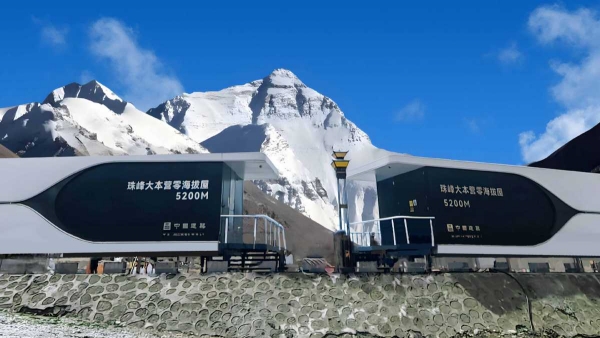
CSCEC's "zero-altitude house" is seen near Mount Qomolangma, Xizang autonomous region. CHINA DAILY
An ongoing construction science and technology exhibition in Beijing is showcasing the latest advancements in sustainable urban development and building technologies, providing a glimpse into a future where intelligent and green construction solutions lead the way.
Several cutting-edge electric vehicle charging technologies and their applications in real-life scenarios are also on display in the smart city section of the CSCEC Science and Technology Exhibition, organized by China State Construction Engineering Corp.
"With our newly developed charging stations, an EV can be fully charged in the time it takes to enjoy a cup of coffee," said Li Renge, director of China State Construction Steel Structure Institute.
Targeting the multibillion-dollar market for EV charging infrastructure, CSCEC has employed for the first time third-generation semiconductor silicon carbide (SiC), liquid cooling, and group management and control technologies, and has finally come up with a 600-kilowatt ultrafast integrated supercharging solution that can deliver continuous full-power output for 72 hours, Li said.
Li is also head of the innovation research and development institute of China Construction Science and Industry Corp, a CSCEC unit.
The system can also weather extreme climatic conditions such as high salinity, high humidity, high heat and severe cold, he added.
The EV charging stations' ultrahigh power charging of 600 kW has increased power density by 25 percent with a charging efficiency of up to 96.34 percent, delivering a super-fast charging experience of 1 kilometer duration per second, CSCEC said.
The 600 kW supercharging technology has already been implemented in over 40 projects nationwide so far, including photovoltaic storage and charging stations in Shenzhen, Guangdong province and Chongqing, it said.
In the outdoor exhibition area, a model of the world's first "zero-altitude house", featuring high-altitude pressurized building techniques, has drawn the attention of visitors.
The product aims to ease the health challenges associated with high-altitude environments, such as acute altitude sickness and long-term physiological damage, and support projects in engineering, medical research and tourism in such regions, said Wang Kaiqiang, deputy chief engineer of China Construction Third Engineering Bureau Co Ltd, a CSCEC subsidiary.
Currently, the "zero-altitude house" has been deployed in various settings, such as the Mount Qomolangma (known as Mount Everest in the West) area, Antarctic research stations, high-altitude military bases, observatories, hotels and residential buildings, providing versatile solutions for diverse environments, Wang said.
Themed "technology empowering a better life, innovation leading China's construction", the exhibition features seven key areas and highlights 167 innovations in digitalization, industrialization and intelligent development of the construction sector.
"The sector should propel industrial innovation through technological advancements, fully exploring new applications and scenarios in emerging fields, while swiftly translating breakthroughs into practical uses across industries and value chains to unlock vast markets and generate greater value," said Ni Hong, minister of housing and urban-rural development, at the expo last week.
Ni said the research, design and manufacturing of construction equipment are closely linked with other industries, which makes it more important to focus on the sector's R&D and continually enhance the brand image of "China-built "projects.
"It is essential to continually strengthen world-leading construction technologies, prioritize overcoming critical technical bottlenecks, and actively promote practical, people-centered building solutions. By enhancing product quality and technological sophistication, we can better drive progress across the industry," the minister said.